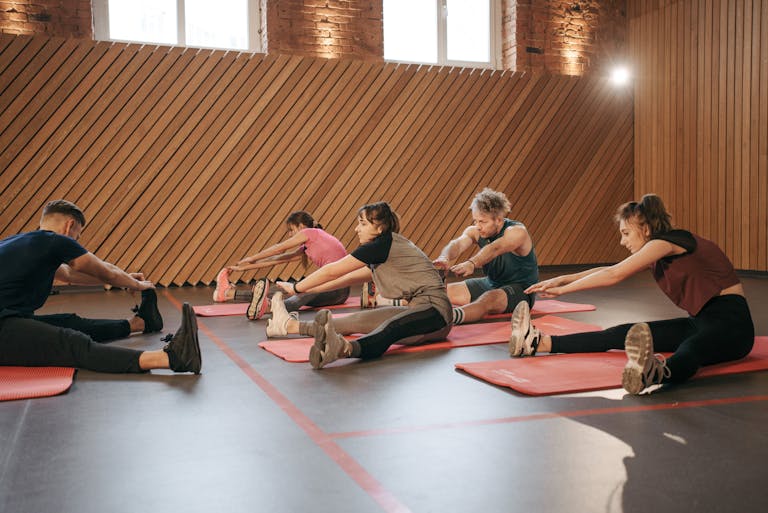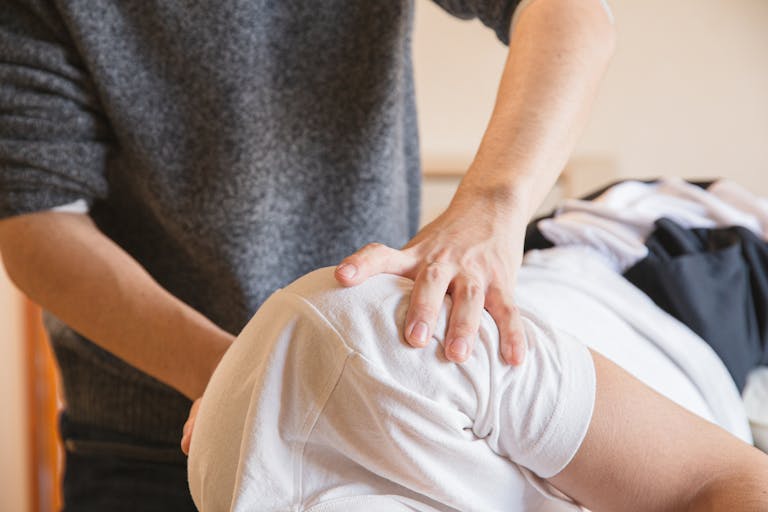Chronic pain affects millions of people worldwide. It’s one of the leading causes of disability. For many, the daily struggle of managing pain can impact their quality of life, mobility, mental health, and productivity. While traditional pain management relies on medications, the growing interest in natural solutions has people looking for options with fewer side effects and long-term benefits.
One of those options? Stretching. Stretching is not just a pre-workout activity or a way to improve flexibility. It’s a powerful natural tool that can help manage and even alleviate chronic pain, relieve pain, and reduce discomfort. This post dives into the science behind stretching, how it reduces pain, and provides a practical guide to incorporating stretching into your daily routine.
What is Chronic Pain and Its Impact
What is Chronic Pain?
Chronic pain is defined as pain that lasts for 12 weeks or more, even after the initial injury or condition causing it has healed. Unlike acute pain, which is a warning signal from the body, chronic pain can persist without any apparent cause. It often shows up in common areas such as the lower back, neck, shoulders, and knees, beyond the usual healing time of an injury or condition. Unlike acute pain, which is your body’s immediate response to harm, chronic pain lingers long after the damage has been repaired and can often occur without a clear cause.
According to the Centers for Disease Control and Prevention (CDC), nearly 20% of adults in the US experience chronic pain. The effects of this condition go beyond physical discomfort. Chronic pain can lead to decreased mobility, disrupted sleep, fatigue, and even mental health challenges like anxiety and depression.
The effects of chronic pain on daily life
Living with chronic pain can be overwhelming. From making it harder to do simple tasks like walking or lifting to its impact on mental health, chronic pain disrupts daily life. Studies show that people with chronic pain are at higher risk of anxiety, depression, and even sleep disorders.
It’s one of the leading causes of disability and impacts quality of life, limits mobility, and daily activities. With the growing preference for natural pain management over pharmaceuticals, stretching has become one of the safest and most effective ways to manage and reduce chronic pain.
According to the CDC, nearly 20% of adults in the US experience chronic pain, making it a common and challenging health issue. While painkillers may provide temporary relief, they’re often accompanied by side effects and dependency risks. This is where natural pain management, especially stretching, comes in as a sustainable and long-term solution. Incorporating simple movements and stretches into daily routines can make pain management more accessible and sustainable.
Imagine waking up with less pain and more freedom to move. Stretching isn’t just about flexibility; it’s a science-backed tool to alleviate chronic pain naturally. Exercise, including stretching, is a safe and effective way to manage chronic pain and overall well-being. This post will take you through how stretching works, its benefits, and simple exercises you can do today.
The Problem with Traditional Pain Management
While pain medications offer temporary relief, they are not without risks. Prolonged use of some medications can result in side effects, dependency, or diminished efficacy over time. This is why many are looking for more natural, sustainable ways to manage their pain – and that’s where stretching comes in.
The Science of Stretching for Pain Relief
How Stretching Physically Affects the Body
Stretching is amazing for our muscles and connective tissues, especially for those with chronic pain. Here’s how:
- Improves blood flow: Stretching increases circulation so our muscles and tissues get the oxygen and nutrients they need for healing and recovery.
- Reduces muscle tension: It helps release tightness in muscles, which can decrease discomfort and increase your range of motion. Stretching is especially good for relieving tight muscles that develop from a sedentary lifestyle or poor posture.
Stretch Away Chronic Pain
The Science of Stretching for Chronic Pain Relief
How stretching benefits the body
Stretching works in amazing ways:
- Improves blood flow: When you stretch, blood flow to your muscles increases, delivering oxygen and nutrients while removing waste products like lactic acid. This process helps tissue repair and reduces tension.
- Reduces stiffness: Stretching increases range of motion by lengthening your muscles and ligaments, combating stiffness that leads to discomfort and injuries.* Activates the parasympathetic nervous system: Stretching helps your body relax, reducing stress, which is often a major factor in chronic pain.
Dynamic stretching – active movements done before exercise – can also increase blood flow and prepare your muscles for physical activity.
Stretching and pain management
Stretching also tackles pain by influencing inflammation and the nervous system:
- Reduces inflammation: Light stretching increases oxygen delivery and circulation to areas of tension, which can lower inflammation and pain intensity.
- Calms the nervous system: Stretching activates the parasympathetic nervous system (your body’s “rest and digest” mode,) which lowers stress hormones linked to pain sensitivity.
- Strengthens weak areas: Chronic pain often comes from muscle imbalances or weak points in the body. Stretching strengthens these areas to prevent long-term issues.
After exercise, incorporating static stretches – where you hold each stretch for 15-30 seconds without bouncing – can increase muscle flexibility, reduce stiffness, and support recovery.
Studies published in the Journal of Pain Research show that regular stretching routines significantly decrease pain scores and improve physical function in people with chronic pain conditions.
The Best Stretching Exercises for Chronic Pain
Full-body stretching routine
Here’s a simple stretching routine made up of simple stretches that are easy to do and suitable for most people. These stretches target common pain points like the back, shoulders, and legs:
- Child’s Pose*(Targets lower back and hips)*
- Start on your hands and knees.
- Sit back onto your heels and extend your arms forward, rest your forehead on the floor.
- Hold for 30 seconds and breathe deeply.
- Cat-Cow Stretch*(Relieves spinal tension)*
- Start on your hands and knees in a tabletop position.
- Arch your back upward into a “cat” position, then lower it into a “cow” position by dipping your belly.
- Repeat for 1-2 minutes.
- Seated Forward Fold*(Stretches hamstrings and lower back)*
- Sit on the floor with your legs straight in front of you.
- Slowly reach forward towards your toes while keeping your back flat.
- Hold for 20-30 seconds.
- Cross-Body Shoulder Stretch*(Releases shoulder tension)*
- Extend one arm across your body.* Pull your arm closer to your chest.
- Hold for 15 seconds on each side.
- Figure Four Stretch*(Opens up hips and reduces lower back tightness)*
- Lie on your back and cross your right ankle over your left knee.
- Pull your left thigh towards your chest.
- Hold for 20-30 seconds per side.
Stretches for specific pain areas
- Lower back pain
These targeted stretches are designed to hit specific muscle groups associated with common pain areas. Try a gentle supine twist by lying on your back, bringing one knee across your body, and twisting your torso.
- Knee discomfort
Focus on quad stretches, like standing on one leg and pulling the opposite foot towards your glutes.
- Shoulder or neck tension
Do neck tilts and shoulder rolls to release upper body stiffness.
For beginners, don’t worry if your flexibility is limited. Start with a smaller range of motion and gradually increase as your body adapts.
Breathing Techniques for Relaxation
Breathing techniques are a powerful yet often overlooked tool in managing chronic pain. When you live with chronic pain conditions, stress and muscle tension can build up and make discomfort even worse. By practicing deep breathing exercises, you can help your body relax, reduce muscle tension, and improve body awareness. Incorporating these into your daily routine not only helps you feel calmer but also supports your body’s natural ability to manage pain.
Taking a few minutes each day to focus on your breath can make a big difference. Deep breathing tells your muscles to relax and helps you tune in to how your body feels, which is key to effective pain management. Over time, this increased body awareness can help you recognize and address areas of tension before they become more painful.
How Breathwork Supports Pain Relief
Breathwork, or consciously controlled breathing, is a simple yet effective way to support pain relief. When you breathe deeply, your body responds by lowering your heart rate and blood pressure, which can ease pain and relax you. Deep breathing also increases oxygen flow to your muscles and tissues, which is vital for reducing inflammation and healing. A physical therapist can work with you to develop a personalized breathing exercise program that suits your needs and goals. By incorporating deep breathing into your exercise routine, you can reduce stress, improve oxygen flow, and help your muscles recover more efficiently. This holistic approach to pain relief can be especially helpful for those with chronic pain as it addresses the physical and emotional aspects of discomfort.
Simple Breathing Exercises to Try
You don’t need any special equipment to start using breathing exercises for chronic pain relief. One effective technique is diaphragmatic breathing. Lie on your back with your knees bent and feet flat on the floor. Place one hand on your belly and the other on your chest. Breathe in slowly through your nose, allow your belly to rise as your diaphragm expands. Exhale gently through your mouth, feel your belly fall. Repeat for several breaths, focusing on the movement of your abdomen.
Another helpful method is box breathing. Inhale through your nose for a count of four, hold your breath for four counts, exhale for four counts, and then hold again for four counts before repeating. This rhythmic pattern can calm your mind and body, making it easier to manage pain and tension. Try incorporating these exercises into your daily routine, especially during moments of increased pain or stress, to help your body relax and recover.
Core Strengthening for Back Health
A strong core is the foundation of a healthy back and plays a big role in reducing chronic pain. Your core muscles – including the abdominal muscles and hip flexors – support your spine and help you maintain good posture throughout the day. By strengthening these muscles, you not only improve your balance but also lower your risk of future injuries that can lead to chronic pain.
Core strengthening is especially important for those with chronic pain, as weak core muscles can contribute to poor posture and increased strain on the back and other joints. Simple core exercises can be added to your daily routine to help you build muscle strength and support your entire body as you move through daily activities.
Why Core Strength Matters for Chronic Pain
For those with chronic pain conditions, building core strength can make a big difference in managing pain and improving overall function. Weak core muscles can lead to instability in the spine, which often results in additional strain on the muscles and joints. This instability can worsen chronic pain, especially in the lower back and shoulders.By adding core strengthening exercises to your exercise routine, you can reduce pain, improve joint flexibility, and support better posture. Exercises that target the abdominal muscles and hip flexors are especially good for maintaining spinal alignment and preventing future injuries. If you’re not sure where to start, a healthcare professional or physical therapist can provide professional guidance and help you design a core strengthening program that suits your needs and fitness level.
Strengthening your core isn’t just about reducing pain – it’s about overall health and giving your body the support it needs to move confidently and comfortably every day. With the right approach, you can take meaningful steps towards managing pain and improving your quality of life.
Tips for Stretching Daily
Consistency is key when it comes to stretching. Stretching daily can improve flexibility, reduce stiffness, and support long-term pain management. Here’s how to make it part of your daily routine:
- Start your day with a stretch
Spend 5-10 minutes stretching after waking up to set a positive tone for the day.
- Combine stretching with existing habits
Stretch while watching TV, before bed, or post-workout for added relaxation and recovery.
- Use props for deeper stretches
Incorporate resistance bands, yoga blocks, or foam rollers to enhance stretches and support good posture.
- Set reminders
Use phone alarms or apps to remind yourself to stretch daily. Over time, it will become second nature.
Stories of Relief
Meet Sarah, 38, who has had lower back pain for years. After just one month of stretching daily, she felt less stiff in the mornings and noticed improved posture.
Or James, 46, who was constantly battling tension in his shoulders. By including a few shoulder and neck stretches during his breaks, James found significant relief from his discomfort and improved focus at work.
These stories show the power of small habits.
Take Control of Chronic Pain Today
Stretching is natural, accessible, and effective for chronic pain. With its science-backed benefits, it can help you improve your quality of life, enable you to move freely again, and work towards a pain-free life.
Start small. Dedicate 10 minutes a day to a stretching routine and build from there. Stay consistent and you’ll see improvements in flexibility, pain levels and overall well being. Get stretching today. Want more guidance or a personalized stretching plan? Sign up for our newsletter or check out our stretching programs for extra support.
Medical Notice:
This blog is for information only and not medical advice, diagnosis, or treatment. Always consult with a qualified healthcare professional before starting any new exercise or stretching program, especially if you have a pre-existing medical condition or chronic pain. Results not typical.







